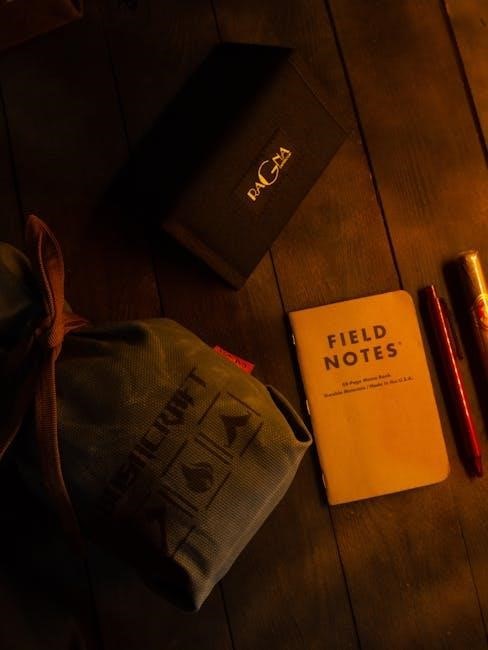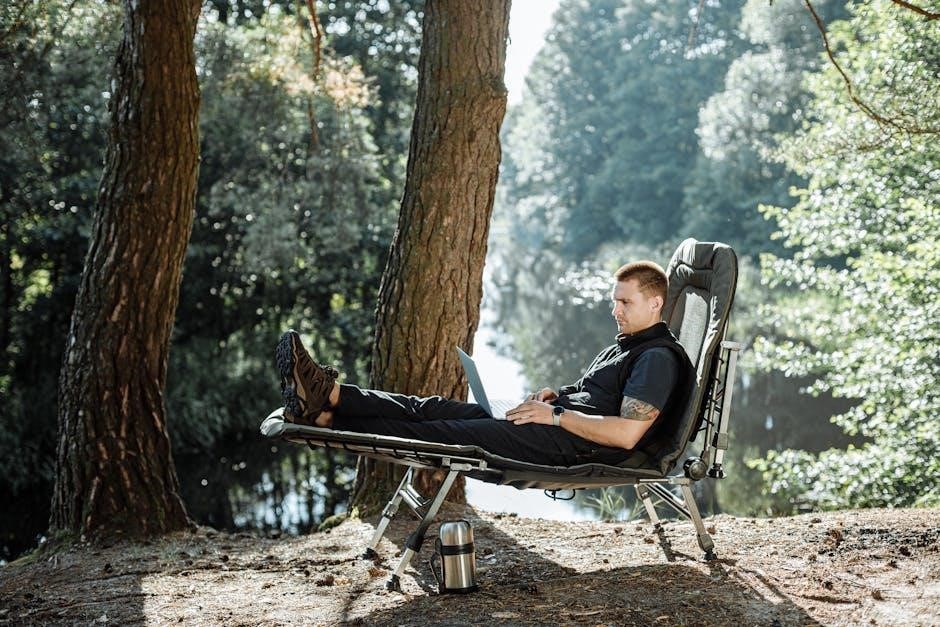Susan Sontag’s “Notes on Camp” explores the concept of camp as an aesthetic sensibility, emphasizing artifice, exaggeration, and irony. This essay has become a cornerstone in understanding camp’s cultural significance.
Overview of “Notes on Camp”
Susan Sontag’s “Notes on Camp” is a seminal essay that delves into the concept of camp as an aesthetic sensibility. First published in 1964, the essay explores camp’s essence, defining it as a unique way of experiencing and interpreting the world. Sontag argues that camp celebrates artifice, exaggeration, and irony, often blurring the lines between high and low culture. The essay is structured as a series of fragmented notes, reflecting the fluid and subjective nature of camp itself. By examining camp’s cultural and historical contexts, Sontag sheds light on its significance in queer aesthetics and its enduring influence on fashion, media, and art. The essay remains a cornerstone in understanding camp’s role in modern culture.
Importance of Understanding Camp Aesthetic
Understanding camp aesthetics is crucial for grasping its cultural and artistic significance. Camp, as explored in Susan Sontag’s essay, challenges traditional notions of beauty and taste by celebrating artifice and exaggeration. It provides insight into how cultural values are constructed and subverted, often blurring the lines between high and low art. By examining camp, one gains a deeper understanding of identity, performance, and the ways marginalized communities reclaim and reinterpret cultural norms. This sensibility not only reflects the interplay between irony and sincerity but also highlights the political and social dimensions of aesthetic expression. Ultimately, camp’s relevance lies in its ability to provoke thought and spark conversations about art, identity, and culture.

Definition of Camp
Camp is an aesthetic sensibility that celebrates artifice, stylization, and exaggeration, often blurring the line between seriousness and irony, as explored in Susan Sontag’s essay.
Overview of the Concept
Camp, as explored in Susan Sontag’s essay, is a cultural and aesthetic phenomenon characterized by artificiality, exaggeration, and irony. It is a sensibility that celebrates the theatrical and the deliberate, often blurring the line between seriousness and humor. Camp is not merely a style but a way of understanding and engaging with the world, emphasizing surface over depth. It challenges traditional notions of beauty and authenticity by embracing the outrageous and the stylized. This concept has evolved over time, becoming a critical framework for analyzing queer aesthetics, performance, and identity. Camp’s relevance lies in its ability to subvert norms and redefine cultural expression.
Susan Sontag’s Perspective
Susan Sontag’s essay “Notes on Camp” is a seminal work that defines camp as a unique aesthetic sensibility. She describes camp as seeing “everything in quotation marks,” emphasizing its artificiality and theatricality. Sontag argues that camp is not just a style but a way of understanding life as performance. She highlights its triumph of the “epicene style,” where gender boundaries blur. Sontag’s perspective also links camp to queer aesthetics, celebrating its exaggerated, ironic, and playful nature. Her work has profoundly influenced cultural and fashion discourse, even inspiring the 2019 Met Gala theme. Sontag’s analysis remains a cornerstone for understanding camp’s enduring relevance in art, identity, and popular culture.
Historical Context of Camp
Camp’s origins trace back to 17th-century Europe, evolving as a coded aesthetic among marginalized groups. It became a queer sensibility, flourishing in subcultures before gaining mainstream recognition.
Origins and Early Examples
The concept of camp traces its roots to 19th-century European art and literature, particularly in the works of Oscar Wilde, who embodies the essence of camp with his wit and theatricality. Early examples of camp can be found in exaggerated theatrical performances and flamboyant fashion, which celebrated artifice over authenticity. The aesthetic gained prominence in the early 20th century through cabaret culture and drag performances, where individuals embraced hyper-stylized personas. These early manifestations laid the groundwork for camp as a distinct sensibility, blending humor, irony, and a rejection of seriousness. Susan Sontag’s essay highlights how these origins evolved into a broader cultural phenomenon, shaping camp’s role in modern aesthetics.
Evolution Over Time
Camp’s evolution began in the 19th century, rooted in European art and theater, where it expressed a playful rejection of seriousness. By the mid-20th century, camp became a coded language for queer communities, symbolizing resilience and self-expression. The 1960s, particularly with Susan Sontag’s essay, marked its transition into mainstream cultural discourse, linking camp to artifice and irony. The 1980s saw camp embraced by pop culture, with figures like Madonna and drag queens embodying its spirit. Today, camp influences fashion, film, and media, blurring boundaries between high art and kitsch. This transformation highlights camp’s adaptability, evolving from a niche sensibility to a global cultural phenomenon, as noted in Sontag’s work and contemporary analyses.

Key Characteristics of Camp
Camp is characterized by its embrace of artificiality, exaggeration, and irony, celebrating style over substance. It often blends high art with kitsch, creating a unique aesthetic.
Artificiality and Exaggeration
Camp thrives on artificiality and exaggeration, embracing the superficial over the sincere. It celebrates the “quotational” nature of objects and identities, where nothing is taken at face value. Camp sees a lamp not as a simple object but as a “lamp,” heightened by its stylized presentation. This sensibility extends to people, where gender and roles become performances rather than natural states. The triumph of the epicene style, blending masculine and feminine traits, exemplifies camp’s rejection of rigid categories. By amplifying the artificial, camp transforms the mundane into the extraordinary, creating a world where life is a theatrical performance. This exaggerated aesthetic challenges conventional notions of authenticity, making it a powerful tool for cultural critique and self-expression.
Irony and Humor
Camp often employs irony and humor to subvert seriousness and highlight the absurd. It thrives on the incongruous, finding delight in the mismatch between intention and result. Camp’s irony is not about mockery but about reveling in the theatricality of life, where even the mundane becomes performative. This sensibility transforms the ridiculous into the sublime, celebrating the over-the-top and the exaggerated. By embracing humor, camp challenges the earnestness of mainstream culture, offering a playful critique of societal norms. Irony, in this context, becomes a tool for self-awareness, allowing camp to both entertain and provoke, blurring the line between sincerity and parody. Through this lens, camp creates a space for liberation and creative expression, where the absurd is not just accepted but celebrated.
Cultural Perception of Camp
Camp is a cultural sensibility celebrating artifice and extravagance, rooted in queer aesthetics. It has sparked both admiration and criticism, reflecting its significant polarizing influence on culture.
Queer Aesthetics and Camp
Camp is deeply intertwined with queer aesthetics, serving as a powerful form of self-expression and resistance. It often embodies exaggerated styles, humor, and irony, allowing queer individuals to reclaim and reinterpret societal norms. Susan Sontag’s essay highlights camp as a sensibility that celebrates artifice and theatricality, resonating deeply with queer culture’s embrace of performance and identity fluidity. Camp provides a platform for queer voices to challenge mainstream perceptions, fostering a sense of community and visibility. Through its playful subversion of norms, camp has become a cornerstone of queer aesthetics, inspiring fashion, art, and media that reflect its bold and unapologetic spirit.
Mainstream Reactions and Criticisms

While camp has gained significant cultural recognition, it has also faced criticism for its perceived superficiality. Mainstream audiences often view camp as overly exaggerated or lacking in depth, which can lead to misunderstandings of its artistic intent. Critics argue that camp’s emphasis on artifice and irony may overshadow more serious themes or messages. However, supporters counter that camp’s ability to challenge traditional aesthetics and norms is a strength, not a weakness. The mainstream’s mixed reactions highlight camp’s polarizing nature, as it continues to influence fashion, media, and entertainment while sparking debates about its cultural value and relevance.
Modern Relevance of Camp
Camp’s influence is evident in contemporary fashion and media, inspiring themes like the 2019 Met Gala. It continues to evolve, blending humor and artifice with cultural shifts.
Influence on Fashion
Camp’s emphasis on artifice, exaggeration, and irony has profoundly shaped fashion, inspiring bold, theatrical designs. Susan Sontag’s essay highlights how camp celebrates the stylized over the natural, influencing designers to embrace extravagance. This aesthetic is evident in runway shows and red-carpet looks, where drama and self-aware humor reign. Camp’s irreverence toward traditional norms has democratized fashion, allowing for experimentation with gender roles and silhouettes. The 2019 Met Gala, themed “Camp: Notes on Fashion,” showcased this influence, featuring outfits that were outrageously playful and politically charged. Camp’s legacy in fashion lies in its ability to blur the line between high art and popular culture, creating a space for creative freedom and cultural critique.
Presence in Media and Entertainment
Camp’s presence in media and entertainment is profound, influencing films, television, music, and performance art. Directors like John Waters and artists like Lady Gaga employ camp aesthetics to create bold, irony-rich narratives. Television shows such as ‘RuPaul’s Drag Race’ celebrate camp through exaggerated personas and theatrical performances. Camp challenges traditional norms, providing a platform for marginalized voices to express themselves humorously and artistically. This aesthetic not only shapes visual styles but also storytelling approaches, attracting audiences who appreciate its blend of humor and artifice. Camp’s influence in media continues to grow, offering a unique lens through which to view and critique culture, fostering both entertainment and cultural reflection.

Camp, as explored in Susan Sontag’s “Notes on Camp,” remains a transformative aesthetic, blending artifice and irony to challenge cultural norms and celebrate extravagance, ensuring its enduring relevance.
Camp, as explored in Susan Sontag’s essay, is a unique aesthetic sensibility characterized by artifice, exaggeration, and irony. It celebrates the superficial and the theatrical, often challenging traditional notions of beauty and seriousness.
Sontag highlights that camp sees life as a performance, where identities and objects are stylized and quoted. This sensibility thrives on the tension between sincerity and parody, making it a powerful tool for cultural critique.
The essay also underscores camp’s connection to queer aesthetics, emphasizing its role in subverting norms and creating a sense of community.
Ultimately, “Notes on Camp” remains a foundational text for understanding the enduring influence of camp in fashion, media, and art. Its insights continue to resonate, offering a fresh perspective on identity and culture.
Future Implications of Camp
Camp’s influence is likely to grow in a world increasingly embracing fluid identities and irony. As digital spaces evolve, camp’s artifice and exaggeration may thrive in virtual realities and social media, where personas are curated and performances are constant.
The sensibility could also deepen its connection to queer culture, becoming a powerful tool for subverting norms and celebrating diversity.
Moreover, camp’s ability to blur boundaries between high and low art may inspire future movements in fashion, film, and theater.
Ultimately, camp’s adaptability ensures its relevance, making it a enduring lens for understanding identity, aesthetics, and cultural transformation in the years to come.
